#Syllabic Script
Explore tagged Tumblr posts
Text
Exploring the Richness of Sinhala: Sinhalese Language of Sri Lanka
Unveiling the Captivating World of the Sinhala Language The Sinhalese language is a linguistic gem with deep roots in Sri Lanka’s vibrant culture and history. With its melodious tones and ancient origins, this Indo-Aryan language has fascinated linguists and culture enthusiasts alike. This article explores the fascinating intricacies of the Sinhala language, exploring its development, its…

View On WordPress
#accessibility#Colloquial Sinhalese#Cultural Significance#Indo-Aryan Language#Language Access#Language Evolution#Language Services#Language Shift#LanguageXS#Linguistic Diversity#Literary Sinhala#Pali Influence#Sanskrit Influence#Sinhala Alphabet#Sinhala Interpretation#Sinhala Language#Sinhala Script#Sinhala Translation#Sinhalese Speakers#SOV Word Order#Sri Lanka Heritage#Sri Lankan Culture#Subject-Object-Verb#Syllabic Script#Vedda Language
0 notes
Text

Eīaşu ouilonio itu eīþei.
Cry on the flowers when you cry.
Because I’m attempting to design the system to be written in any direction this sentence starts in the center and is written outward both directions.
#conlang#constructed language#translation#conscript#constructed script#artlang#quote#this is going better than I expected#but it is crazy#logographic script for an inflectional language?#I made a complicated syllabic system to inflect and decline
21 notes
·
View notes
Text
The Evolution of the Alphabet: A Story of Human Ingenuity and Innovation 🤯
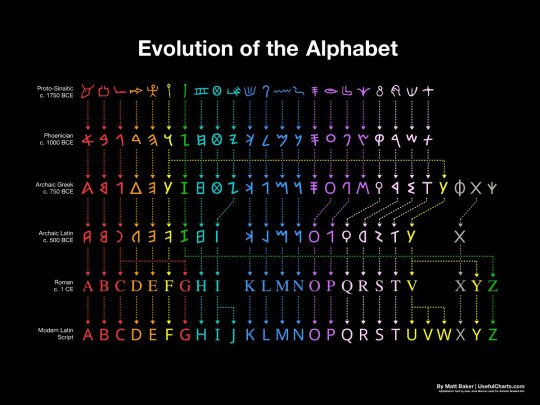
How the Alphabet Changed the World: A 3,800-Year Journey
The evolution of the alphabet over 3,800 years is a long and complex story. It begins with the ancient Egyptian hieroglyphs, which were a complex system of pictograms and ideograms that could be used to represent words, sounds, or concepts. Over time, the hieroglyphs were simplified and adapted to represent only sounds, resulting in the first true alphabets.
The first alphabets were developed in the Middle East, and the Phoenician alphabet is considered to be the direct ancestor of the Latin alphabet. The Phoenician alphabet had 22 letters, each of which represented a single consonant sound. This was a major breakthrough, as it made it much easier to write and read.
The Phoenician alphabet was adopted by the Greeks, who added vowels to the system. The Greek alphabet was then adopted by the Romans, who made some further changes to the letters. The Latin alphabet, as we know it today, is essentially the same as the Roman alphabet, with a few minor modifications.
The English alphabet is derived from the Latin alphabet, but it has undergone some further changes over the centuries. For example, the letters "J" and "U" were added to the English alphabet in the Middle Ages, and the letter "W" was added in the 16th century.
The evolution of the alphabet has had a profound impact on human history. It has made it possible to record and transmit knowledge, ideas, and stories from one generation to the next. It has also helped to facilitate communication and trade between different cultures.
The alphabets are a fascinating invention that have revolutionized the way humans communicate and record information. The history of the alphabets spans over 3,800 years, tracing its origins from the ancient Egyptian hieroglyphs to the modern English letters.
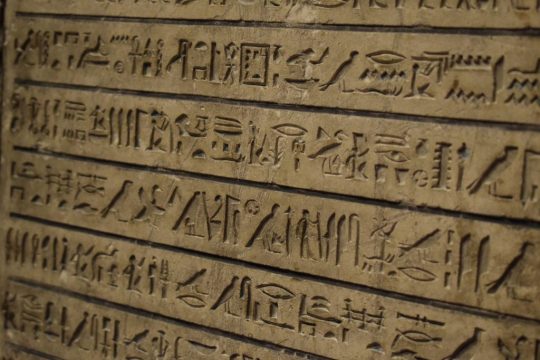
Here is a brief overview of how the alphabets have evolved over time:
Egyptian hieroglyphs (c. 3200 BC): The earliest form of writing was the pictographic system, which used symbols to represent objects or concepts. The ancient Egyptians developed a complex system of hieroglyphs, which combined pictograms, ideograms, and phonograms to write their language. Hieroglyphs were mainly used for religious and monumental purposes, and were carved on stone, wood, or metal.
Proto-Sinaitic script (c. 1750 BC): Around 2000 BCE, a group of Semitic workers in Egypt adapted some of the hieroglyphs to create a simpler and more flexible writing system that could represent the sounds of their language. This was the first consonantal alphabet, or abjad, which used symbols to write only consonants, leaving the vowels to be inferred by the reader. This alphabet is also known as the Proto-Sinaitic script, because it was discovered in the Sinai Peninsula.
Phoenician alphabet (c. 1000 BC): A consonantal alphabet with 22 letters, each of which represented a single consonant sound. The Proto-Sinaitic script spread to other regions through trade and migration, and gave rise to several variants, such as the Phoenician, Aramaic, Hebrew, and South Arabian alphabets. These alphabets were used by various Semitic peoples to write their languages, and were also adopted and modified by other cultures, such as the Greeks, Etruscans, and Romans.
Greek alphabet (c. 750 BC): The Greek alphabet was the first to introduce symbols for vowels, making it a true alphabet that could represent any sound in the language. The Greek alphabet was derived from the Phoenician alphabet around the 8th century BCE, and added new letters for vowel sounds that were not present in Phoenician. The Greek alphabet also introduced different forms of writing, such as uppercase and lowercase letters, and various styles, such as cursive and uncial.
Latin alphabet (c. 500 BC): The Latin alphabet was derived from the Etruscan alphabet, which was itself derived from the Greek alphabet.
Roman alphabet (c. 1 CE): The Roman alphabet is essentially the same as the Latin alphabet, as we know it today. The Latin alphabet was used by the Romans to write their language, Latin, and became the dominant writing system in Europe after the fall of the Roman Empire. The Latin alphabet was also adapted to write many other languages, such as Germanic, Celtic, Slavic, and Romance languages.
English alphabet (c. 500 AD): The English alphabet is derived from the Latin alphabet, but it has undergone some further changes over the centuries. For example, the letters "J" and "U" were added to the English alphabet in the Middle Ages, and the letter "W" was added in the 16th century. The English alphabet consists of 26 letters, but can represent more than 40 sounds with various combinations and diacritics. The English alphabet has also undergone many changes in spelling, pronunciation, and usage throughout its history.
The evolution of the alphabet is a remarkable example of human creativity and innovation that have enabled us to express ourselves in diverse and powerful ways. It is also a testament to our cultural diversity and interconnectedness, as it reflects the influences and interactions of different peoples and languages across time and space.
Thank you for reading! I hope you enjoyed the post about the evolution of the alphabet. If you did, please share it with your friends and family. 😊🙏
#evolution of the alphabet#history of writing#alphabet#hieroglyphs#proto-sinaitic script#phoenician alphabet#greek alphabet#roman alphabet#english alphabet#language#linguistics#consonantal alphabet#syllabic alphabet#ancient egyptian#greek mythology
20 notes
·
View notes
Text
babygirl I can make the ugliest fucking attempt at copying down the tengwar you have ever seen
#this is a sequel to ‘babygirl I can draw the ugliest fucking hexagon you have ever seen’ which was a frequent thought (and discord status)#I had during the organic chemistry unit in high school#elli rambles#anyway I’m not planning to actually learn any elvish languages but I really love trying to learn non-latin scripts#like I know the greek alphabet (or at least the lowercase letters) the inuktitut syllabics (though I probably need to go over those again#bc I feel like I’ve forgotten them a bit)#and now the tengwar & maybe the cirth too#and I also want to learn the hebrew alphabet some time in the future
2 notes
·
View notes
Text
welp
i can confirm i can kinda write in devanagari now 👍
#the talkies tag#man that was fun#it was really cool because the idea to put the transliterated hindi right below the devanagari script popped into my head#and by golly when i say that was a great idea#surely providence lol XD but because of it i got to begin to pick up on the syllabic representations#and now i know maybeee a third to a half of hindi-devanagari syllables?#the common ones at least ^-^#i love hindi
1 note
·
View note
Text
Kryptonian Omegaverse

I almost never do fanart, but I wanted to do SOMETHING to thank @suzukiblu for all their wonderful fic. They've been playing with Darren Doyle's Kryptonian conlang, and I thought, "I can do conscript calligraphy! I'll just write some of their omegaverse terminology and some of the characters' names!"
This was supposed to be a few hours work, two Saturdays ago. That isn't what happened. Instead, I have STRUGGLED. Absolutely every aspect of this script has challenged me. It looks so INNOCENT, but lineweight, scaling, stroke style, character positioning ... everything has required pages of notes, trying to figure out how to make it work in my style.
This is my 6th good copy. I also have at least 10 pages of notes and practice. I had to do WORLDBUILDING (in an earlier post also tagged 'kryptonian') to try to justify how I'm drawing the circles. And you'll notice that this isn't even my full original idea!
Here is the Kryptonian for 'Alpha', 'Omega', and 'Beta', along with ideographic glyphs I designed for the three. The ideographs are combinations of the glyphs for 'my', and 's', 't', and 'k', respectively.
Names are still coming. But it's been over a week, and I needed to share something before I got overwhelmed. Now the project is smaller, and I might be able to finish!
(Rin, I decided to include the syllabic nasal at the beginning of ":dho kyn-tul". And write it with an 'n', instead of with the colon. But if you want to ignore it, just erase the three dots at the beginning of the phrase!)
#think I have a SLIGHTLY better method for the next part#which will lead to a cleaner result in less time#we'll see!#kryptonian#superfamily#conlang#conscript#gecko writes pretty
66 notes
·
View notes
Text
Asivia: The Marriage Hunter, Former Party Member




(This is an excerpt from my essay, Real World Cultural and Linguistic References in Delicious in Dungeon)
ASIVIA
(Japanese Pronunciation: Ashibia)
Asivia (アシビア) is a female magic user that was in the Touden party before Marcille. She’s a pretty woman who tries to take advantage of Laios’ trusting nature, and is referred to at one point as a “marriage-seeker”, implying that she is a gold-digger, looking to find a man who has recently struck it rich in the dungeon and marry them now that they have money. Laios seems oblivious to the fact that she’s using him. When Laios, under pressure from the rest of the party, tells Asivia that he can no longer give her special treatment, she immediately leaves.
Asivia is a name that comes from the precursor to Ancient Greek, Linear B. Linear B is a syllabic script that was used for writing in Mycenaean Greek, the earliest known form of the Greek language.
Asivia (𐀀𐀯𐀹𐀊/Ασίfια/a-si-wi-ja) is identified as an “ethnic name” on a chart I found online about names and words in Linear B, but it doesn’t specify what ethnicity. It most likely comes from the Hittite word Assuwa (𒀸𒋗𒉿, aš-šu-wa).
I found that asivia/asiwija was a word used to refer to a portion of northwestern Anatolia called Lydia. Later this word came to mean the world east of Greece in general, and eventually evolved into the English word Asia, so Asivia means a person from Lydia/east of Greece/Asia.
Lydia was an Iron Age kingdom located in modern day Turkey, and the name comes from Ancient Greek Λυδία (Ludía, “the region of Lydia”), from λυδία (ludía, “beautiful one, noble one”). The given name Lydia originally indicated ancestry or residence in the region of Lydia.
So Asivia’s name may be telling us where she’s from. In Dungeon Meshi’s case, it could mean she is from “Asia” meaning the Eastern Archipelago, or it could mean she is from the “East”, as in the Eastern Continent, where the story takes place. Since she looks like she has brown or red hair, I think she’s probably from the Eastern Continent. Her name could also be a joke about how she’s a pretty girl and Asivia means someone from Lydia, since Lydia/Ludia means “beautiful one” in Greek.
MISTRESS OF THE DUNGEON
Asivia/Asiwija also has a connection to the Ancient Greek word potina (𐀡𐀴𐀛𐀊/πότνια/po-ti-ni-ja), which means "Mistress, Lady", and is an honorific title used both for mortal women and goddesses. In the case of goddesses, it’s a euphemism used in place of their actual names, and Asivia/Asiwija is one of the descriptive words that has been found frequently accompanying potina. “Potina Asivia” means “Mistress/Goddess from the East.”
Despoina, another euphemistic title used the same way, means mistress of the house, and a famous use is a mysterious, nameless, "Mistress of the labyrinth", who was worshiped in Minoan Crete, the place where the Minotaur was supposedly imprisoned. The tale of the Minotaur and the labyrinth has deep connections to the world and plot of Dungeon Meshi, which I go into more in Chapter 12 (Elven Culture).
Asivia was not Laios’ mistress, obviously, but she wanted to be! And if she hadn’t left, and had become Laios’ lover, then maybe she would have been called the Mistress of the Dungeon (labyrinth) at the end of the story…
#dungeon meshi#delicious in dungeon#dunmeshi#spoilers#laios touden#dungeon meshi research#dungeon meshi spoilers#The Essay
312 notes
·
View notes
Photo

Linear B Script
Linear B script was the writing system of the Mycenaean civilization of the Bronze Age Mediterranean. The syllabic script was used to write Mycenaean Greek from c. 1500 to c. 1200 BCE. It was deciphered by Michael Ventris in 1952, and so the script has provided invaluable insights into the Mycenaean culture and its interaction with contemporary Mediterranean civilizations.
Early Aegean Syllabic Scripts
Two scripts of note were already in use in the Bronze Age Aegean before the Linear B script. These were Cretan Hieroglyphic script, in use from around 2000 to 1650 BCE, and Linear A script, in use from around 1850 to 1450 BCE. Both scripts were used by the Minoan civilization (c. 2000 to c. 1450 BCE) centred on Crete and spread to other islands such as Thera, Rhodes, and the Cyclades group. Neither of these scripts has yet been deciphered, but we do know that they were used for administrative and religious purposes, most often as inscriptions on clay tablets. While the Cretan Hieroglyphic script gradually went out of favour, the Linear A script was in use across Crete by the late 16th century BCE. Linear A script is composed of at least 90 characters, which can be grouped into syllabic signs, ideograms, and symbols which denote numbers and fractions. In addition, monograms were made from the clustering of two or three symbols. Around 70% of Linear A symbols reappear in the Linear B script of Mycenaean Greece. Just as the Mycenaean civilization of mainland Greece came to culturally dominate and appropriate elements of Minoan culture from the mid-15th century BCE, so too elements of the older Minoan script were absorbed within the Mycenaean writing system.
Continue reading...
59 notes
·
View notes
Text
Mycenaean Greek
(and examples of lexical evolution to Modern Greek)
Mycenaean Greek is the most ancient attested form of the Greek language (16th to 12th centuries BC). The language is preserved in inscriptions of Linear B, a script first attested on Crete before the 14th century BC. The tablets long remained undeciphered and many languages were suggested for them until Michael Ventris, building on the extensive work of Alice Kober, deciphered the script in 1952. This turn of events has made Greek officially the oldest recorded living language in the world.
What does this mean though? Does it mean that a Modern Greek could speak to a resurrected Mycenaean Greek and have an effortless chat? Well obviously not. But we are talking about the linear evolution of one single language (with its dialects) throughout time that was associated with one ethnic group, without any parallel development of other related languages falling in the same lingual branch whatsoever.
Are we sure it was Greek though? At this point, yes, we are. Linguists have found in Mycenaean Greek a lot of the expected drops and innovations that individualised the Hellenic branch from the mother Proto-Indo-European language (PIE). In other words, it falls right between PIE and Archaic Greek and resembles what Proto-Greek is speculated to have been like. According to Wikipedia, Mycenaean Greek had already undergone all the sound changes particular to the Greek language.
Why was it so hard to decipher Linear B and understand it was just very early Greek? Can an average Greek speaker now read Linear B? No. An average Greek speaker cannot read Linear B unless they take into account and train themselves on certain rules and peculiarities that even took specialized linguists ages to realise and get used to. Here's the catch: Linear B was a script inspired by the Minoan Linear A, both of which were found in the Minoan speaking Crete. (Minoan Linear A inscriptions have yet to be deciphered and we know nothing about them.) The Mycenaeans (or was it initially the Minoans???) made only minimal modifications to produce the Linear B script and used it exclusively for practical purposes, namely for accounting lists and inventories. Linear B however was an ideographic and syllabic script that stemmed from a script that originally was not designed to render the Mycenaean Greek language, and thus it could not do it perfectly. In other words, the script itself does not render the Greek words accurately which is what made it extremely hard even for the linguists to decipher these inscriptions. Due to its limited use for utility and not for prose, poetry or any other form of expression, the Mycenaean Greeks likely did not feel compelled to modify the script heavily into some more appropriate, accurate form to cover the language's needs.
Examples of the script's limitations:
I won't mention them all but just to give you an idea that will help you then read the words more easily:
In the syllabic script Linear B, all syllable symbols starting with a consonant obligatorily have a vowel following - they are all open sylllables without exception. Linear B can NOT render two consonants in a row which is a huge handicap because Greek absolutely has consonants occuring in a row. So, in many cases below, you will see that the vowel in the script is actually fake, it did not exist in the actual language, and I might use a strikethrough to help you out with this.
For the same reason, when there are consonants together, at least one of them is often casually skipped in Linear B!
There were no separate symbols for ρ (r) and λ (l). As a result, all r and l sounds are rendered with the r symbol.
Exactly because many Greek words end in σ, ς (sigma), ν (ni), ρ (rho) but in Linear B consonants must absolutely be followed by a vowel, a lot of time the last letter of the words is skipped in the script!
Voiced, voiceless and aspirate consonants all use the same symbols, for example we will see that ka, ha, gha, ga all are written as "ka". Pa, va, fa (pha), all are written as "pa". Te, the are written as "te".
There are numerous other limitations but also elements featured that were later dropped from the Greek language, i.e the semivowels, j, w, the digamma, the labialized velar consonants [ɡʷ, kʷ, kʷʰ], written ⟨q⟩, which are sometimes successfully represented with Linear B. However, that's too advanced for this post. I only gave some very basic, easy guidelines to help you imagine in your mind what the word probably sounded like and how it relates to later stages of Greek, and modern as is the case here. That's why I am also using simpler examples and more preserved vocabulary and no words which include a lot of these early elements which were later dropped or whose decoding is still unclear.
Mycenaean Linear B to Modern Greek vocabulary examples:
a-ke-ro = άγγελος (ágelos, angel. Notice how the ke symbol is representing ge, ro representing lo and the missing ending letter. So keep this in mind and make the needed modifications in your mind with the following examples. Also, angel actually means "messenger", "announcer". In the Christian context, it means "messenger from God", like angels are believed to be. So, that's why it exists in Mycenaean Greek and not because Greeks invented Christianity 15 centuries before Jesus was born XD )
a-ki-ri-ja = άγρια (ághria, wild, plural neuter. Note the strikethrough for the nonexistent vowel)
a-ko-ro = αγρός (aghrós, field)
a-ko-so-ne = άξονες (áksones, axes)
a-na-mo-to = ανάρμοστοι (anármostoi, inappropriate, plural masculine. Note the skipped consonants in the script)
a-ne-mo = ανέμων (anémon, of the winds)
a-ne-ta = άνετα (áneta, comfortable, plural neuter, an 100% here, well done Linear B!)
a-po-te-ra = αμφότερες (amphóteres, or amphóterae in more Archaic Greek, both, plural feminine)
a-pu = από (apó, from)
a-re-ka-sa-da-ra = Αλεξάνδρα (Alexandra)
de-de-me-no = (δε)δεμένο (ðeðeméno, tied, neuter, the double de- is considered too old school, archaic now)
do-ra = δώρα (ðóra, gifts)
do-ro-me-u = δρομεύς (ðroméfs, dromeús in more Archaic Greek, runner)
do-se = δώσει (ðósei, to give, third person singular, subjunctive)
e-ko-me-no = ερχόμενος (erkhómenos, coming, masculine)
e-mi-to = έμμισθο (émmistho, salaried, neuter)
e-ne-ka = ένεκα (éneka, an 100%, thanks to, thanks for)
e-re-mo = έρημος (érimos, could be pronounced éremos in more Archaic Greek, desert)
e-re-u-te-ro-se = ελευθέρωσε (elefthérose, liberated/freed, simple past, third person)
e-ru-to-ro = ερυθρός (erythrós, red, masculine)
e-u-ko-me-no = ευχόμενος (efkhómenos or eukhómenos in more Archaic Greek, wishing, masculine)
qe = και (ke, and)
qi-si-pe-e = ξίφη (xíphi, swords)
i-je-re-ja = ιέρεια (iéreia, priestess)
ka-ko-de-ta = χαλκόδετα (και όχι κακόδετα!) (khalkóðeta, bound with bronze, plural neuter)
ke-ka-u-me-no = κεκαυμένος (kekafménos, kekauménos in more Archaic Greek, burnt, masculine)
ke-ra-me-u = κεραμεύς (keraméfs, kerameús in more Archaic Greek, potter)
ki-to = χιτών (khitón, chiton)
ko-ri-to = Κόρινθος (kórinthos, Corinth)
ku-mi-no = κύμινο (kýmino, cumin)
ku-pa-ri-se-ja = κυπαρίσσια (kyparíssia, cypress trees)
ku-ru-so = χρυσός (khrysós, gold)
ma-te-re = μητέρα (mitéra, mother)
me-ri = μέλι (méli, honey)
me-ta = μετά (metá, after / post)
o-ri-ko = ολίγος (olíghos, little amount, masculine)
pa-ma-ko = φάρμακο (phármako, medicine)
pa-te = πάντες (pántes, everybody / all)
pe-di-ra = πέδιλα (péðila, sandals)
pe-ko-to = πλεκτό (plektó, woven, neuter)
pe-ru-si-ni-wo = περυσινό / περσινό (perysinó or persinó, last year's, neuter)
po-me-ne = ποιμένες (poiménes, shepherds)
po-ro-te-u = Πρωτεύς (Proteus)
po-ru-po-de = πολύποδες (polýpoðes, multi-legged, plural)
ra-pte = ράπτες (ráptes, tailors)
ri-me-ne = λιμένες (liménes, ports)
ta-ta-mo = σταθμός (stathmós, station)
te-o-do-ra = Θεοδώρα (Theodora)
to-ra-ke = θώρακες (thórakes, breastplates)
u-po = υπό (ypó, under)
wi-de = είδε (íðe, saw, simple past, third person singular)
By the way it's killing me that I expected the first words to be decoded in an early civilisation would be stuff like sun, moon, animal, water but we got shit like inappropriate, salaried and station XD
Sources:
gistor.gr
Greek language | Wikipedia
Mycenaean Greek | Wikipedia
Linear B | Wikipedia
John Angelopoulos


Image source
#greece#history#languages#linguistics#greek#greek language#langblr#mycenaean greek#modern greek#greek culture#language stuff#vocabulary#linear b#mycenaean civilization
144 notes
·
View notes
Text
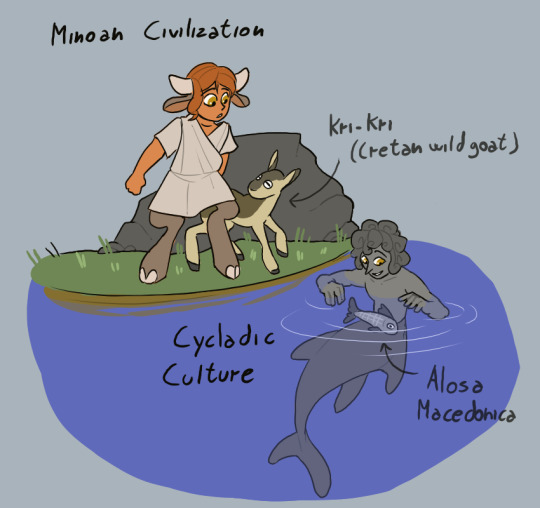

Re-Drew these three! Gave them some animals ! Kri-Kri - "The kri-kri is not thought to be indigenous to Crete, most likely having been imported to the island during the time of the Minoan civilization."
Alosa macedonica -"The specific name means "of Macedonia", the refion of Greece to which thuis fish is endemic." (I just wanted to take an endemic fish of Greece to also use later for Macedonia) Mammuthus creticus- "an extinct species of dwarf mammoth endemic to Crete sometime during the Early Pleistocene to early Middle Pleistocene." Decided to make then the Mycenaen Civilization's animal because of the fact that Fossils of prehistoric elephants may have inspired the Greek myth of the Cyclope! A copy and paste of the previous post with them: The Cycladic culture was a Bronze Age culture (c. 3100–c. 1000 BC) found throughout the islands of the Cyclades in the Aegean Sea. Being a Culture between islands I decided to make them dolphins , (the current national animal of Greece!) to make then swim around the islands !
The Minoan civilization was a Bronze Age culture (3100 – c. 1100 BC) which was centered on the island of Crete.
Decided to keep them a Minotaur!
Mycenaean civilization was the last phase of the Bronze Age in ancient Greece, spanning the period from approximately 1750 to 1050 BC. It represents the first advanced and distinctively Greek civilization in mainland Greece with its palatial states, urban organization, works of art, and writing system.
Kept them as a Cyclop for Cyclopean masonry: "...Pausanias attributes all of the fortifications of Tiryns and Mycenae, including the Lion Gate, to the Cyclopes..." also : "Mycenaean Greek is the earliest attested form of the Greek language, dating back to the Mycenaean civilization (16th to 12th centuries BC) on the Greek mainland and Crete. It was written in the Linear B script, a syllabic system, and was primarily used for administrative and economic records rather than literary works."
#countryhumans#countryhumans bronze age#countryhumans cycladic culture#countryhumans minoan civilization#countryhumans mycenae#countryhumans Mycenaean civilization
17 notes
·
View notes
Text
7 undeciphered writing systems
(While reading, remember that it’s possible to decipher a script and still not understand the language that the script represents.)
(Each heading links to that script's respective Wikipedia page.)
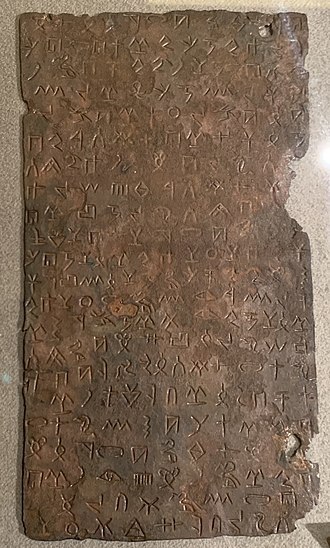
Byblos Syllabary
The Byblos syllabary is attested in 10 inscriptions found in Byblos, a coastal city in Lebanon. It likely represents a Semitic language, but despite a handful of attempts at decipherment, there still isn’t a consensus as to what sound each character represents.

Cypro-Minoan Syllabary
The Cypro-Minoan syllabary appears on ~250 objects—especially clay balls and cylinders that were used for recording economic transactions—on the island of Cyprus.
The script suddenly disappears in 950 BCE and was replaced by the Cypriot syllabary, which was used to write Greek, and based on Cypro-Minoan. This evolution allows us to infer the sounds of some of the signs in Cypro-Minoan, but we still don’t know what language it represented—probably either Minoan or Eteocypriot.
There are only ~2,500 total instances of signs for Cypro-Minoan, which is significantly less than Linear B when it was deciphered (~30,000).
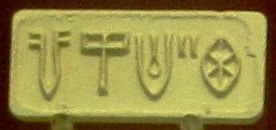
Indus Valley Script
The Indus Valley script is known from ~4,000 objects with very short inscriptions found in and around the Indus Valley, and represents the Harappan language (the unknown language of the Indus Valley civilization).
It has about 400 distinct signs, which is too many for each sign to represent a single sound or syllable, but too few for each sign to represent a word. Scholars thus think the system is logo-syllabic (basically a mix of the two).
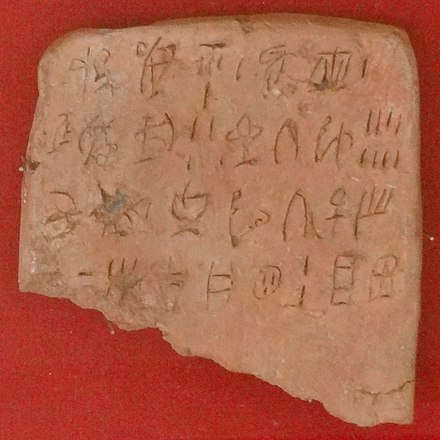
Linear A
Linear A: Everybody’s favorite mysterious undeciphered script. Linear A was used by the Minoans on the island of Crete, and is called “linear” because the script is written by cutting lines into clay, rather than pressing wedges into clay like cuneiform.
Linear A was adapted to write Mycenean Greek and became Linear B (deciphered in the 1950s), and because of this we can infer many of the sound values of symbols in Linear A. However, 80% of Linear A’s signs are unique, not shared with Linear B.
Linear A itself probably developed from the earlier Cretan hieroglyphs, which are also undeciphered.
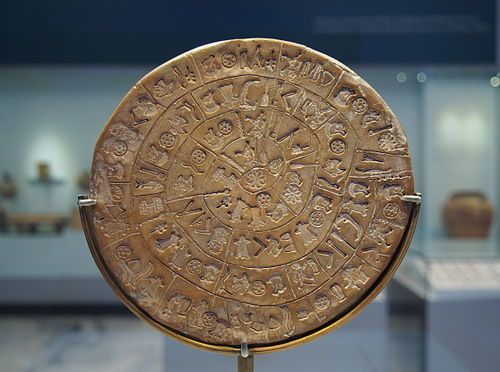

Phaistos Disk
The Phaistos Disk. Also from the Minoan civilization on Crete, yet seemingly unrelated to Linear A. This disk is the only certain attestation of this (assumed) script, spiraling around both sides. There are 242 tokens comprising 45 distinct signs.
The Phaistos Disk also happens to be an early example of moving type printing, since each character was made by pressing seals into clay.
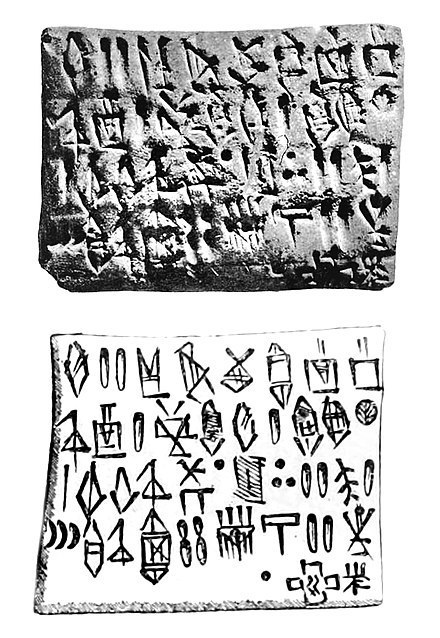
Proto-Elamite
The Proto-Elamite script developed alongside Proto-Cuneiform, and was used for similar functions and in similar ways until it was replaced by cuneiform. Proto-Elamite, like cuneiform, began as a system of marking tokens and spheres with details of economic transactions.

Rongorongo
Rongorongo is a system of glyphs used on Rapa Nui (Easter Island), found only on about two dozen wooden objects. According to oral history, the tablets were considered sacred, and only a small elite class could read them. Unfortunately, that tradition was wiped out after slaving raids and epidemics caused the collapse of Rapa Nui society.
Though the glyphs, if they are writing, undoubtedly represent the Rapa Nui language, little is known about it because modern Rapa Nui has had heavy influence from Tahitian.
---
Want to learn more about the world’s writing systems and their history? Check out my curated list of books on Writing & Writing Systems!
460 notes
·
View notes
Text
290 notes
·
View notes
Text
Updated: Kishite-Shabalic Script and a bit of the Kishic Language: Basics including an expanded list of nouns and verbs
I made this before but looking through it again I missed some things and made some mistakes, and so here is an updated version of this for y'all! As with the Kishite spoken language, the Kishic script descends from and is largely identical to the Shabalic script, thus the term Kishite-Shabalic. Kishite-Syllabic is one of three scripts used in Kishetal along with Kishic hieroglyphs (reserved for religious/cultic purposes) and the logographic Shetalic script, which has fallen almost entirely out of favour.
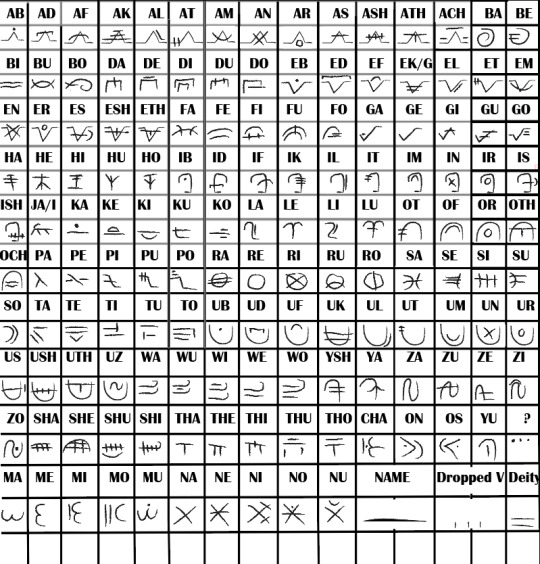
The Kishite-Shabalic script is syllabic, thus each symbol is representative of one syllable composed of a consonant and a vowel. In addition there are characters which serve as punctuation used to symbolize the conclusion of a thought, in similar fashion to the Latin "." and "?", and the presence of a proper noun or divine status. Though it should be noted that these are not always actually used.
Unlike the Shetalic script which is traditional formed using styluses pressed into clay, Kishite-Shabalic is typical written either through carving or the use of charcoal/ink.
Shetalic is shown below on the left with Kishite-Shabalic on the right, both say the same thing.

Keep reading for more linguistic babbling!
Vowels
As a general rule when transcribing the Kishite script, when two of the same vowel are put next to one another, they are treated as a single vowel, rather than elongated as we might see in English with words like book or meet or feat. Two different vowels, such as O and E, E and A, and so on, are almost never put directly beside each other. In the rare instances when this does occur the "stronger" of the two vowels will cover the other. The order of strength from least to greatest is as follows:
i-e-a-o-u
The vowels of the Kishite language are pronounced phonetically
Thus:
I as in sweet or pin
E as in egg
A as in palm
O as in coat
U as in tool
e.g. the substantive adjective "the Mighty" Urjali- + -ul (substantive ending) Urjaliul Urjaliul Urjalul (OOr-Jahl-OOl)
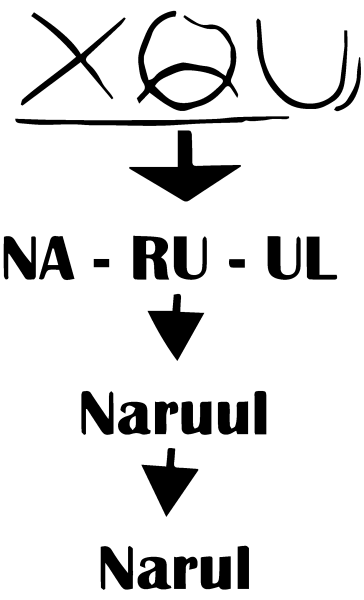
Special Note: One important differentiation between the Shabalic language and the Kishite language is that the Kishite language allows for the placing of multiple consonants in sequence. Take for example the Kishic name Ninma, in its original Shabalic form it would be Ninama (NI-NA-MA). Because of the fact that Kishite does have this trait, it has developed its own unique form of punctuation, the vowel drop. When placed below one of the syllabograms shown above, it cancels out the vowel, in essence rendering it mute. Ninma could alternatively be spelled using the formulation NI-IN-MA, similar to how Narul was spelled above, this is largely a matter of personal preference. The more traditional (Shabalic) form is often times considered more in keeping with nobility.
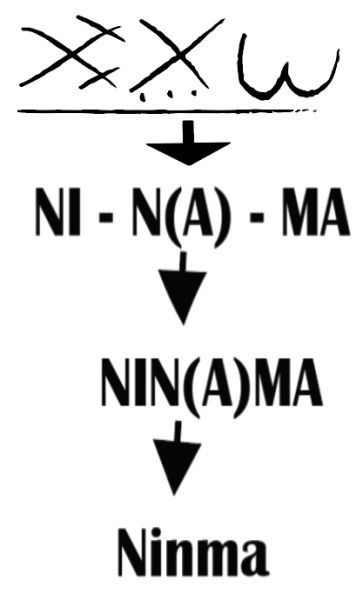
Sentence Structure
The Kishic language primarily follows a subject-object-verb structure.
Naru(u)l Nina(a)ma kimagiga(a)s Narul Ninma kimagigas. Narul Ninma carried. Narul carried Ninma.
Tamel kim(u)unur fabiguta(a)s Tamel kimunur fabigutas Tamel gates broke. Tamel broke gates.
Otilya (there is no -ia symbol in Kishite) Korithub luku ga. Otilya Korithub luku ga Otilia Korithia from is. Otilia is from Korithia
Enni Wi tuba chi Jahubur horu jawishaga The wind down the Mountain hard blows. The wind blows hard down the mountain.
Noun and Adjective Declensions
The Kishic language system consists of the following cases: nominative, genitive, dative, accusative, and possessive (the Shabalic language includes an instrumental case), and distinguishes between two numbers (singular and plural) and four genders, Masc/Neutral (undefined groups or individuals), Feminine, Inanimate, and Divine.
Divine beings such as gods and certain spirits as well as the Sun, Mountains, Rivers, and the Sea are always referred to in the Divine gender. Some monsters also fall under this category. (Water Bi (Inanimate), Lake Bi (Divine))
Objects which are not and have never been alive are rendered in the Inanimate gender. This can get confusing in some instances, for example while the word corpse Nahoku would utilize the masc/neutral form, the word bone, hashudi, would utilize the inanimate. Another example of this is the word Oli which can mean either blood or wine based on whether it utilizes masc/neut or inanimate declensions.
Not all inanimate objects are rendered into the inanimate. Words like spear shukala use the masc/neutral. This group typically consists of weapons and tools. The stem used will depend on the root word.
Plants as a rule are always rendered into the feminine.
Cities and countries are neutral.
Royal Titles have a specific declension.
A few examples of declension are given in the tables below.
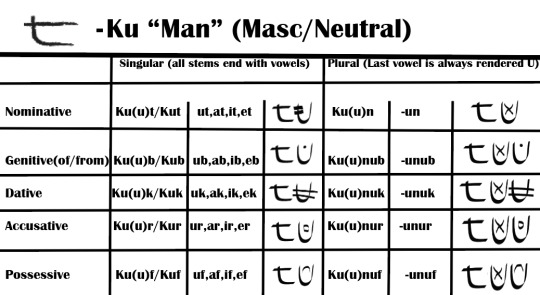

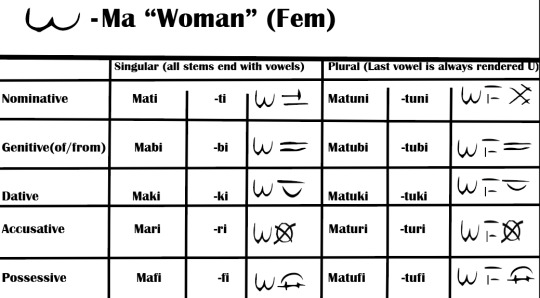
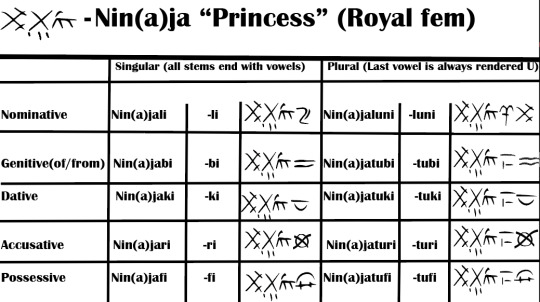


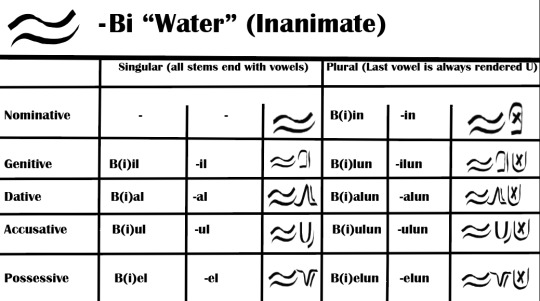
Sample Verbs
Verb stems always end with -i. The exception to this is the verb to be, which rather takes the form of the conjugation, thus the first person singular indicative present sample or "am" would be wa.
Talk: Akki
Breathe: Ki
Eat: Ushki
Struggle: Nari
Sleep: Eshsi
Fight: Orishri
Hunt: Pabakazi (Literally Bow art(ing))
Dance: Irteti
Kiss: Mishuzi
Copulate (and the more vulgar equivalent): Seshiti/Tu(u)ki
More verbs will be provided below.
Verbal Conjugation
There are two conjugation groups within Kishite verbs, the ha/za/hi-conjugation and the wa/ya/wi-conjugation. Which conjugation is used is dependent on the verb in question, typically words with a Shabalic root use the wa -conjugation while words derived from native languages more often use the ha -conjugation.
Within the Kishite language there are two voices (active and medio-passive), three moods (indicative, subjunctive, and imperative), three aspects (perfective, imperfective/continuous, and simple), and three tenses (Past, Present, and Future)
The present tense can be identified by -i/-a/-u/-o, past by -as/-os/-us, and future by -ad/-id.
Indicative: Used for Stating facts and thus the mood of reality.
Active: The Subject is the agent of the verb.
Mediopassive: The agent acts as a reflexive agent of the verb (acting upon itself) OR the subject is the target of the verb.
Present Simple Active: Narul is hungry Past Simple Active: Narul was hungry Future Simple Active: Ninma will not be hungry Present Simple Mediopassive: Narul is accompanied by Ninma/ Narul cleans (himself). Past Simple Mediopassive: Narul was accompanied by Suru Future Simple Mediopassive: Narul will be accompanied by Mikrab Present Perfect Active: Narul has slept Past Perfect Active: Narul had slept Future Perfect Active: Narul will have slept. Present Perfect Mediopassive: Bop has been carried Past Perfect Mediopassive: Bop had been carried Future Perfect Mediopassive: Bop will have been carried Present Imperfective/Continuous Active: Narul is walking Past Continuous Active: The Deep Sun used to speak Future Continuous Active: Zatar will be fighting Present Continuous Mediopassive: Bop is being carried Past Continuous Mediopassive: Bop was being carried Future Continuous Mediopassive: Bop will be being carried
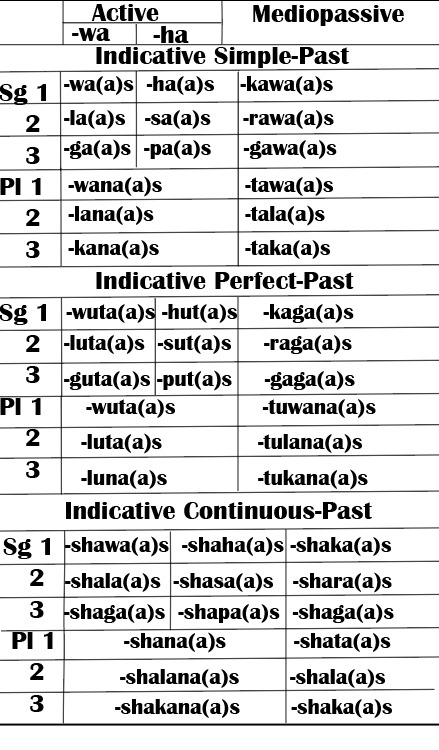

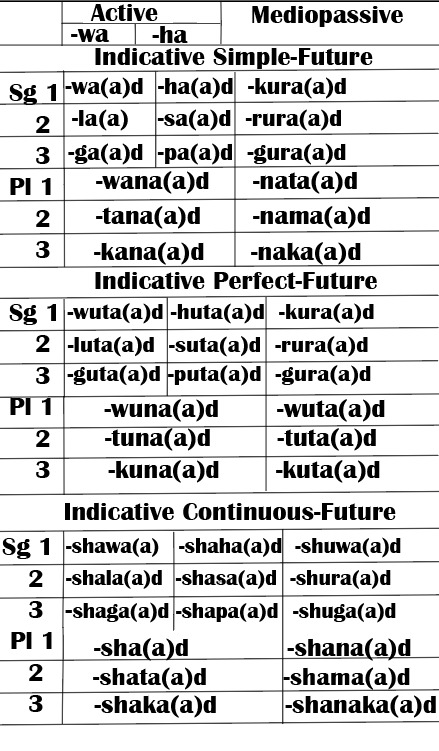
To make a phrase conditional, add Ek-, before the indicative form.
Subjunctive: Used for stating "unfacts", wishes and prayers, statements of necessities (you must) possibilities (may or might), hypotheticals, and opinions/judgements.
There is no Future conjugation for the Subjunctive, rather future events are expressed in the present through the use of may or might.
Additionally the Subjunctive is used for the following:
Jussive: used for suggestions and negative commands: What "should" or "should not" happen used only in the first person," we should leave/we should not leave" esh = should, na(e)sh = should not
Indefinite clauses: (if/until/whenever/whoever/however) ek = if, ekib = until, kowa(a)b =whoever, bowa(a)b = whenever, lowa(a)b = wherever, mowa(a)b = however
Purpose Clauses: "So that/ in order that" am = so that/in order that
Doubtful Assertions: "May not/Might not" er = may/maybe, na(e)r = may not, eb = might, nab = might not
Certain Future Assertions: "There certainly will..." erna = certainly (literally without maybe), na(e)rna = certainly not
Present Simple Active: We should run/ Narul wishes for rain Past Simple Active: Narul wished for rain Present Simple Mediopassive: If Ninma is stopped Past Simple Mediopassive: If Ninma was stopped Present Perfect Active: Narul has wished for rain Past Perfect Active: Narul had wished for rain Present Perfect Mediopassive: If Bop has been carried Past Perfect Mediopassive: If Bop had been carried Present Imperfective/Continuous Active: Narul is wishing for rain Past Continuous Active: Narul used to wish for rain Present Continuous Mediopassive: If Bop is being carried Past Continuous Mediopassive: If Bop was being carried
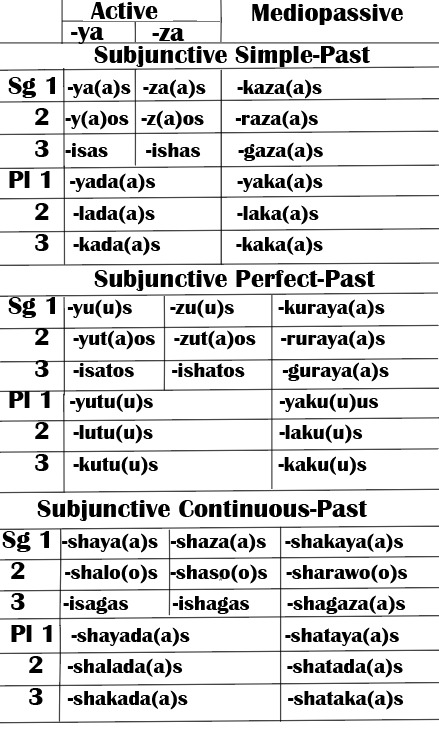
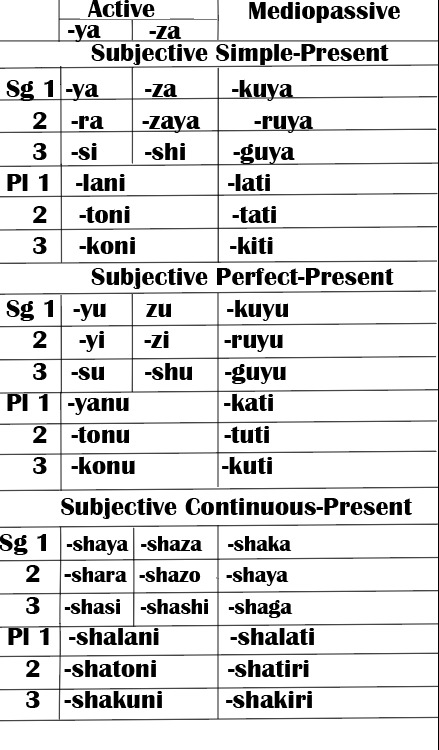
Imperative: Used for orders or commands/strong requests
Imperative is only conjugated in the second and third person singular or plural. Imperative is only used in the present and future, not for the past. Orders in the past are expressed as indicative. There are only Perfect and Imperfect Imperatives.
In the mediopassive form the imperative is translated as "Let them/you" for the first person of this the subjunctive is used "I/We should"
Present Perfect Active: Stop Future Perfect Active: You will stop Present Perfect Mediopassive: Let it stop Future Perfect Mediopassive: Let it be stopped. Present Imperfective/Continuous Active: Always stop Future Continuous Active: You will always stop Present Continuous Mediopassive: Let it be stopped (continuously) Future Continuous Mediopassive: Let it be stopped (continuously)
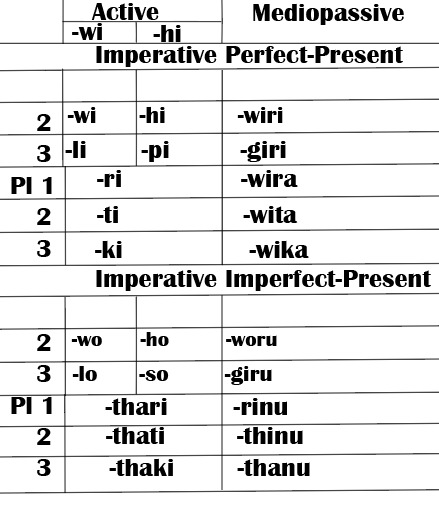
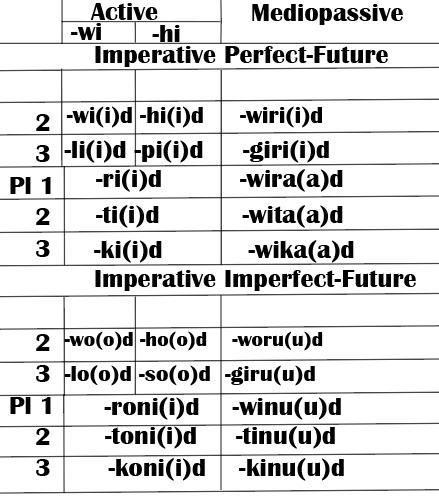
coAdditionally, the verbal system displays infinitives and participles in the present and past tenses.
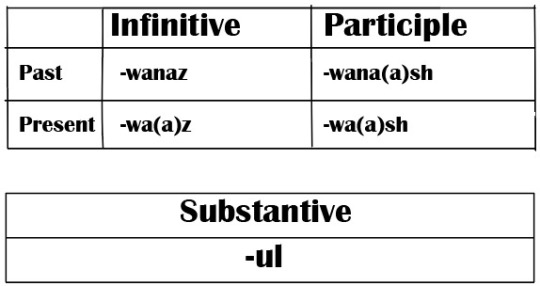
Prounouns
There are four genders of pronouns; Masculine, Feminine, Neutral, and Divine. Objects with the Inanimate designation are given neutral pronouns. Only deities receive divine pronouns, other entities and places in the divine categorization will typically receive feminine pronouns, with the exception of celestial bodies which always receive masculine pronouns.
It is considered improper to address both royalty and deities with pronouns, as such there are no specific first or second person pronouns for the Divine category.
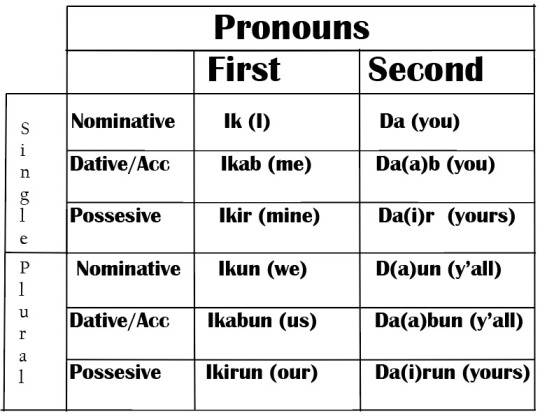
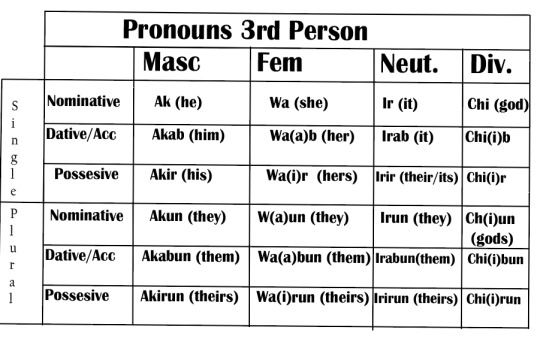
Articles
As with pronouns there is no "inanimate" article group, rather inanimate subjects are given masc/neut articles.

Stay Tuned for the ridiculously long Dictionary post that will be coming soon(ish)!
This post and the dictionary post are why, despite being back, I still haven't been all that active. I'll respond to a couple tag games tonight and I'll try to do more tomorrow. I'm still planning on doing the Korithian Recipes! Money is just tight at the moment so I'm waiting for paychecks!
If y'all notice any mistakes or typos in this, send me a message so I can fix them! Same goes for if you have questions!
@illarian-rambling, @mk-writes-stuff, @kaylinalexanderbooks, @willtheweaver, @patternwelded-quill
@elsie-writes, @elizaellwrites, @the-ellia-west, @the-octic-scribe, @the-golden-comet
@finickyfelix, @theprissythumbelina, @autism-purgatory, @diabolical-blue , @tildeathiwillwrite
@katenewmanwrites, @leahnardo-da-veggie, @paeliae-occasionally, @melpomene-grey
@drchenquill, @marlowethelibrarian, @winterandwords, @phoenixradiant, @pluttskutt
@dyrewrites, @unrepentantcheeseaddict, @roach-pizza, @rivenantiqnerd, @pluppsauthor
@flaneurarbiter, @dezerex, @axl-ul, @surroundedbypearls
@treesandwords, @the-golden-comet
#testamentsofthegreensea#writeblr#fantasy writing#worldbuilding#conlang#conscript#writing#fantasy#narul#fantasy world#world building
63 notes
·
View notes
Text
Writer tip: Repeating a character trait doesn't make it true.
"he/she/they were clever." said ad nauseum doesn't make it true. Prove it in the text, demonstrate it.
I mean you could tell me. And you could show me the university certificate, but it doesn't make it true and I won't believe you.
s/He was an inventor. Fine. He was an inventor, then demonstrate it in the text. Are they a one-trick pony and can't apply it after you introduce it? Then I think he stole the invention. He doesn't know how it works, can't demonstrate it being useful in other applications, can't figure out how to invent anything on the spot, has no mind of being an engineer. I don't believe you. Give me the mindset of the person.
The person was intelligent... again, demonstrate this is true in the text by them using words in context that makes them sound emotionally and intellectually intelligent. I'd be much more impressed if they were explaining fancy mathematical theory to a three year old using three-year old language than I would be them using long multi-syllabic words at random. That takes extra intelligence, to me. Fermat's Theorem AND be sensitive enough to get a Three year old's attention, hold it, and get the kid to understand. That's like intelligence on steroids.
It's not show or tell in this case, it's *actually put it into the text* instead of slamming me with the character trait over and over.
If I went around telling everyone every ten seconds I was smart, and I was clever, would you believe me? If I said I got into Yale, maybe you would wince and ask something like, Iunno, were you a nepo?
But if I told you I watched an episode of MacGyver and then broke apart a mechanical pencil for the spring and used some sticky tack to fix a screen door. That would lead some credence to how I was smart.
(BTW, he wasn't fixing a screen door in the episode).
If I told you I used dental floss to make a locking door open from the other side, you might believe me (It was a lunchroom push door. I'd gone to the dentist the previous day and had it in my pocket. I got sick of getting up for the door, so rigged it.)
BTW, this isn't a copy-paste moment, but to think up your own creative solutions to problems and try to borrow the mindset of everything can be fixed with duct tape, for example.
In another words, the more I demonstrate the logic, the mindset, then you'll start to believe me.
This person was creative. Still doesn't make it true. This person did avante garde paintings challenging colonialism and a dying planet using mixed mediums and trash, might tip those scales.
Frankly, I don't care if you tell me, or if you show me, just demonstrate it on the page it's true instead of repeating it over and over at me.
Go MacGyver with your engineer. Know your art movements for your artist. Know your pirouettes for your ballerinas. Pick up at least a fraction of the mindsets, so when Iunno, a computer engineer looks at someone saying the UX person told them that the program functions, but it doesn't actually work, it makes sense. (I saw a Japanese drama do this brilliantly, BTW, and I was delighted. On the flip side, I've seen people try to pass HTML and Javascript as "programming" especially badly formatted Javascript. I'm looking at you Square Space. WTF was with that badly formatted Javascript and calling that "programming". I may lack game, but seriously, that's not a good advertisement. Look, our program spits out terrible javascript and we don't know what programming and scripting is...) This is why the best writers are nerds. Wok Hei for your Chinese chef. I spent 3 hours looking up old waterwheels to get the engineering.
Again, don't use AI to get there, do the work and find an edge to play with. A gap. Because AI can't find gaps. A lot of professions have mindsets or varying mindsets. And if you capture that, you'll get ahead. Did I watch Cells at Work because doctors highly recommended the anime, yes I did. But I also picked up how doctors think.
BTW, dropping into process story structure for a little bit to demonstrate the impact or the brilliance of a chef, a painter, an engineer, etc usually tips people over the edge. It doesn't have to consume that long in the book either.
24 notes
·
View notes
Text

It took a little longer than expected, but we got there! Lets talk about syllables, sounds, and the writing system.
The writing system is a syllabic alphabet, i.e. it has forms for individual letters corresponding to individual sounds, but they are arranged into blocks each corresponding to a single syllable. Let's take a look at an example, Kuembros.

If a syllable starts with a consonant, it goes on the left. The only consonant clusters in this language are formed with a plosive followed by an r, which is marked in the top left if present. The vowel(s) go in the top right. If there is a consonant at the end, it is written at the bottom connected to the initial consonant. Otherwise, a simple horizontal line takes its place.
Here are the consonants with their corresponding glyphs. Only m, n, and s may be at the end of a syllable. Their ending forms are shown underneath the table.
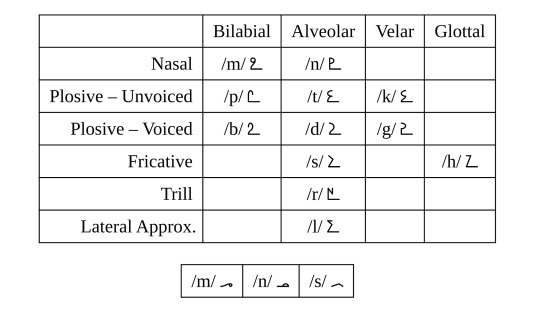
The first table below shows the plain vowels. This is the 5-vowel system. The second table shows the possible vowel combinations along with their typical realizations. Some of these are long vowels which are held for a greater duration (e.g. ā /aː/), some are diphthongs which glide from one vowel to another (e.g. /ai/ as in eye), and some starting with an i or u may be realized as a semivowel (y in you, and w in we respectively). Note that the IPA symbol for the English consonant y is /j/.
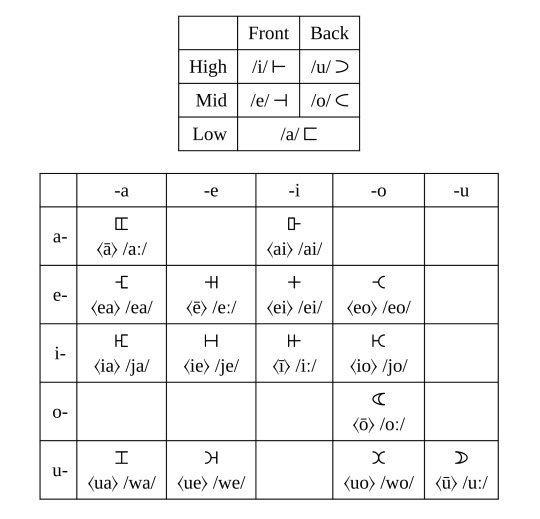
So there we have it. If you want to puzzle out some examples of the script, the banner at the top contains some randomly generated syllables of various forms.
Next up: People, Places and Things
#conlang#constructed language#artlang#neography#constructed script#orthography#conworld#worldbuilding#fantasy worldbuilding#Kvembrian#Kvember
22 notes
·
View notes
Text

@connortheconceded
There was never a script developed for use in clay or a time in which clay has been the predominant medium for the written language, but there were and are practices of inscribing clay tokens as records of transaction analogous to some of the predecessors of cuneiform (and using clay for permanent recordkeeping in general).
These originated similarly as clay tablets representative of sold/stored goods, which would be stored in sealed bulla (mostly in cylinder form) to avoid tampering. This practice has survived the development of a full writing system and widespread use of paper, as a means of having a permanent and unambiguous record of transactions (though generally in addition to paper records in the case of official entities).

The top row here shows an older variant wholly predating the modern writing system, probably around 800 years old. These are clay tokens that would be sealed in a bulla, accounting for sales of horses and grain. The left indicates a sale of eighteen female and six male horses. The right indicates a sale of maize in seven now obsolete units of measurement.
The bottom shows contemporary clay tokens that serve as permanent records of transactions. The left indicates a very large purchase of horses (twenty seven females, five males, and thirteen geldings). The right is a record of a tributary take, consisting of eleven unwatse (standardized unit of grain measurement in the form of a vessel) of maize and one gelding ox. The characters have been imprinted with pre-made stamps for each commodity, while the numerical values are hand carved.
The contemporary version uses established and fairly formalized logographs, most of which no longer have immediate visual clarity in meaning (the character for 'horse' particularly has been stylized beyond recognition over time). The counting system has remained virtually unchanged over the centuries, as with the logographs indicating sex (with the only change being a fusion with the 'fertility' character to indicate intact and presumably fertile animals, which is absent on the symbol indicating a gelding).
The backs will be stamped with an official seal of the individuals or state entities involved in the transaction. In the case of tributary takes, the tributary party's name is written in syllabic script by a state official scribe (or signed themselves, in the rare case of literacy) and 'stamped' by the party in question by pressing their finger into wet clay.
31 notes
·
View notes